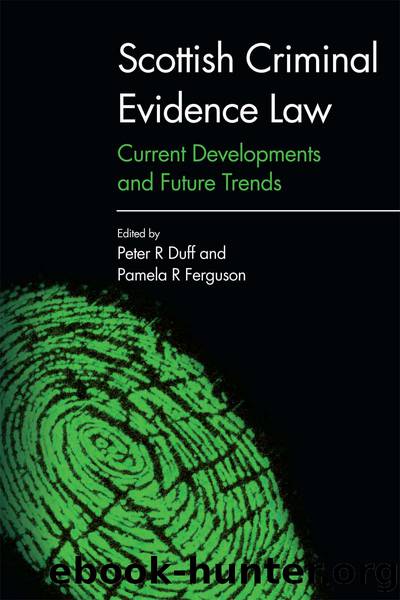Scottish Criminal Evidence Law by Duff;Ferguson;

Author:Duff;Ferguson;
Language: eng
Format: epub
Publisher: Edinburgh University Press
Chapter 6
Eyewitness identification evidence and its problems: recommendations for change
Pamela R Ferguson*
INTRODUCTION
Identification of the accused as the perpetrator of a crime has been the subject of many Scottish appeals.1 Where identification is a contested issue, the prosecution may establish that the accused and the perpetrator are synonymous by a variety of means, such as fingerprint2 or DNA evidence,3 voice recognition,4 or eyewitness identification.5 This chapter focuses on the last of these, since it is widely accepted that the most common cause of wrongful convictions is mistaken eyewitness identification.6 The chapter is in three parts: Part A describes the various forms of eyewitness identification procedures employed in Scotland; Part B considers the problems associated with this type of evidence and critiques the Scottish approach; and Part C argues that we need to reform our processes if we are to avoid wrongful convictions. It makes ten principal recommendations for change.
As explained in Cairnsâs earlier chapter, the Carloway Review of 2010 recommended that the corroboration requirement be abolished. The controversy this engendered caused the Scottish Government to establish an Independent Reference Group (the Post-Corroboration Safeguards Review), chaired by Lord Bonomy, to make further recommendations.7 His Lordship formed an Academic Expert Group (AEG) whose remit was to prepare a preliminary report for the Bonomy Committee on types of evidence which are notorious for causing miscarriages of justice.8 These included false or fabricated confessions; evidence given by accomplices and informers; hearsay evidence; and eyewitness misidentifications.9 As a member of the AEG, I was responsible for reporting on the last of these topics. The removal of the corroboration requirement could prove particularly problematic in respect of these forms of evidence. On the day on which Lord Bonomyâs committee submitted its report,10 the Scottish Government announced that it would reconsider its decision regarding corroboration.11 This review process has revealed that our laws and procedures in relation to eyewitness identification evidence are in need of reform â and this is so, whatever the fate of the corroboration requirement.
A. SCOTTISH EYEWITNESS IDENTIFICATION PROCEDURES
(1) Pre-trial identification
A witness to a crime may point out the perpetrator to the police during or in the immediate aftermath of a crime. This so-called âstreet identificationâ could be spontaneous, where the witness takes the initiative,12 or the police may show a suspect to a witness and ask whether or not the witness can confirm that this is the perpetrator. In 2007, the Scottish Lord Advocate issued revised Guidelines on the Conduct of Visual Identification Procedures.13 These provide that where a witness has made such an identification, the police officer should record the details, including where and how the identification was made, and the conditions at the time, including the distance between witness and suspect, the weather and lighting conditions, etc.14
Another informal method of identification is the âshowupâ, in which the police show a single photograph of a suspect to a potential witness, sometimes several weeks or months after the incident. The Guidelines specify that this should be done using an emulator sheet15 containing photographs of at least eleven other persons who resemble the suspect.
Download
This site does not store any files on its server. We only index and link to content provided by other sites. Please contact the content providers to delete copyright contents if any and email us, we'll remove relevant links or contents immediately.
The Borden Murders by Sarah Miller(4021)
The Secret Barrister by The Secret Barrister(3423)
Coroner's Journal by Louis Cataldie(2360)
Police Exams Prep 2018-2019 by Kaplan Test Prep(2359)
The Splendid and the Vile by Erik Larson(2229)
Terrorist Cop by Mordecai Dzikansky & ROBERT SLATER(1965)
My Dark Places by James Ellroy(1805)
A Colony in a Nation by Chris Hayes(1797)
Black Klansman by Ron Stallworth(1705)
The Art of Flight by unknow(1695)
A Life of Crime by Harry Ognall(1596)
Objection! by Nancy Grace(1569)
The New Jim Crow by Michelle Alexander(1549)
Whoever Fights Monsters by Robert K. Ressler(1534)
Anatomy of Injustice by Raymond Bonner(1530)
Invisible Women by Caroline Criado Perez;(1516)
Obsession (The Volkov Mafia Series Book 1) by S.E Foster(1496)
American Prison by Shane Bauer(1480)
A is for Arsenic: The Poisons of Agatha Christie (Bloomsbury Sigma) by Kathryn Harkup(1456)
